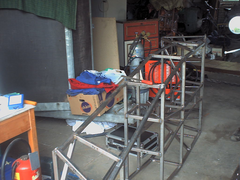
1 last welding question
Z20let Corsa - 11/12/08 at 05:45 PM
right im nearly there. been doing a bit of practice and im pretty happy with the results. there are actually 2 questions. what do i need to alter to
get the weld to penetrate into the metal im welding more? and also my welds seem to have little air bubbles in them. i thought this was lack of gas at
1st but its definately turned up enough, how do i tell how much gas is in the bottle?? thanks.
dogwood - 11/12/08 at 05:55 PM
What welder are you using?
Usually more power means better penetration.
Holes in your welding could be contaminants, rust/ grease etc
Don't think there is any way of telling how much gas is left unless you have a regy gauge
HTH
blakep82 - 11/12/08 at 06:17 PM
more power for more penetration, but you may need to turn the wire speed down a bit too
maartenromijn - 11/12/08 at 06:22 PM
As above. And, as far as I know, but when you weld 'pushing', it will penetrate better then 'trailing' (I don't know the
correct English terms). If you are not sure about the quality, cut open a few welds to check the penetration.
I thought it is standard to have a pressure gauge for the bottle, and a flow gauge. I always use 10 litres/min and the result is fine.
In the picture you can see the twin gauge gas set on the gas bottle. Sorry for this bad pic, but this is all I have athe moment.


Rescued attachment 24-08-03 0002.jpg
gjs - 11/12/08 at 06:42 PM
if the gas bottle is a full size it should have 2500-3000 psi on gauge,a flow meter is better as mentioned,also check no draughts blowing,wind etc,it
will blow the gas from the weld area.
you could slow down a bit when welding,its hard to tell unless i can see what you are doin.Welding is usually best when everything is constant,travel
speed arc length,gas pressure,cleanliness etc etc
[Edited on 11/12/08 by gjs]
dogwood - 11/12/08 at 06:44 PM
quote:
Originally posted by maartenromijn
I thought it is standard to have a pressure gauge for the bottle, and a flow gauge. I always use 10 litres/min and the result is fine.
In the picture you can see the twin gauge gas set on the gas bottle.quote:
Yes most welders do, but hobby welders only have a gas flow adjuster with no gauge.
So no way of telling how much gas is left.

[Edited on 11/12/08 by dogwood]
maartenromijn - 11/12/08 at 09:30 PM
quote:
Yes most welders do, but hobby welders only have a gas flow adjuster with no gauge
I'm using it for my hobby...
thomas4age - 13/12/08 at 02:51 PM
are you sure the gass reaches the end of the welding torch?
I worked a welder with a non detachable torch once, and there was a break in the gas line halfway down the torch flexi bit.
replaced it with a ESAB torch and socket, and the owner has never had problems since, results where the same, tiny pockets in weld seam.
Grtz Thomas
Peteff - 13/12/08 at 04:33 PM
If you're using co2 from a cylinder with a dip tube it could be freezing up at the moment 
jacko - 13/12/08 at 06:11 PM
Are you pushing the torch or pulling it ?
you should push so the gas cleans and puts a shield around the weld your doing
Mark Allanson - 13/12/08 at 08:09 PM
quote:
Originally posted by jacko
Are you pushing the torch or pulling it ?
you should push so the gas cleans and puts a shield around the weld your doing
Pushing the torch technique only applies to long passes, almost all welds on a locost chassis are 1" long so you should be 90° to the weld in all
planes and as close as you can reasonably get.





